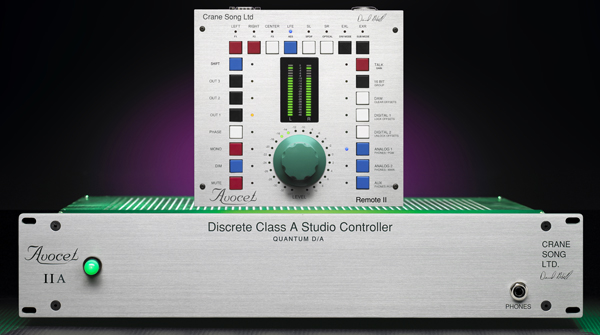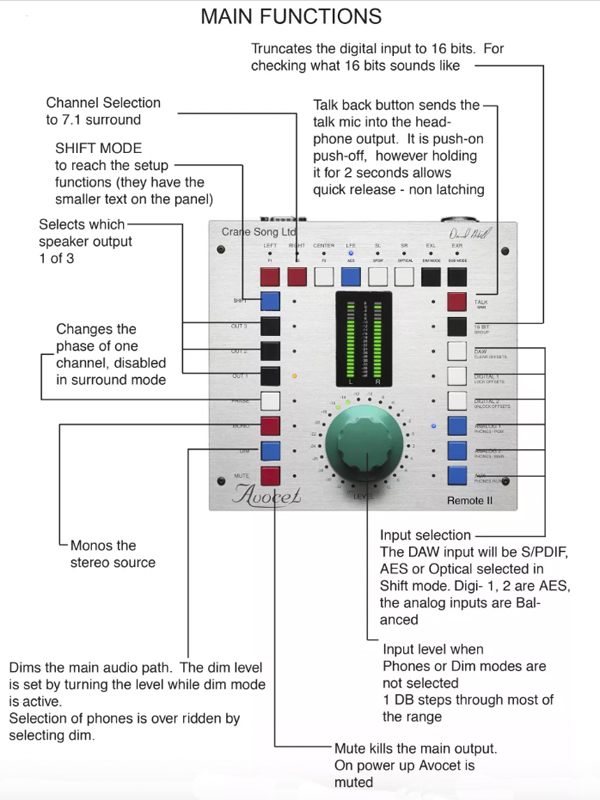
Barry's Mix Magazine Equipment And Software Reviews
Barry's Massive Discography And Engineering Career
Barry's Music Connection Magazine Reviews
Barry's Resolution Magazine Reviews
Crane Song Ltd. Avocet IIA Monitor Controller
By Barry Rudolph
 | Complete Avocet 2A with Audio Chassis |
Since its inception in 2004 as a stereo-only unit, the Avocet Discrete Class-A Monitor Controller has evolved through revisions and functional enhancements to become Crane Song's most successful product, with the Avocet IIA the pinnacle of Dave Hill's design. Reviewed here is the Avocet IIA stereo system, comprising a two-rackspace audio chassis connected (over a 25-foot cable) to the Avocet Remote II tabletop unit.
For surround sound monitoring, up to four 2U audio chassis can be controlled from a single Avocet Remote to accommodate up to 7.1 channels (three chassis required for 5.1). For surround operation, the rear panel 25-pin D-sub accessory sockets are repurposed (internal ribbon cable change) so that each chassis is interconnected to operate in designated pairs of surround channels. An experienced tech can handle the proper connections.
The Avocet Remote IIA (firmware 12) retains the familiar and basic look of previous versions, with its 24 flush-mounted push-buttons surrounding a large green master volume/gain parameter control (encoder) knob and 20-segment LED level meter. The horizontal top row of Left, Right, Center, LFE, SL, SR, EXL, EXR channel selection buttons includes an additional row of eight Shift-Setup Mode sub-functions. The encoder and all buttons are made by Grayhill. The switches are rated at 500,000 cycles, while the encoder is rated at 1 million operations.
On the rear panel of the remote is a 15-pin D-sub for connection to the audio chassis, plus an XLR input for a talkback mic. I have the Remote II sitting on the right side of my desktop, angled slightly up--otherwise it would normally lie flat.
All behaviors, setups and configurations of the Avocet system are done using the remote. After selecting a function and then holding its button down until its LED flashes--about a half-= second--you'll be in Gain trim mode. There is also a blue Shift-mode button for setting certain functions, static configurations, and Talkback mic level and monitor Dim level. The IIA allows all output levels to be adjusted in .25dB steps (maximum -15.75dB), so there is no more need of inline attenuator pads to match different level requirements of powered speakers and/or power amps.
 |
| Crane Song LTD Avocet IIA Monitor Controller Main Functionality |
When powered on, the Avocet comes up in Mute mode while the saved settings and firmware load, with enough time allowed for stabilization of the new Quantum digital-to-analog converter. When powered off, all configurations and resident firmware version are held in an EEPROM chip.
Audio Chassis
I tested Avocet's latest stereo audio chassis (firmware 13.1). The entire audio path is discrete analog electronics with balanced output amps and premium op-amp chips around the Quantum DAC, the same converter and clock used in Crane Song's standalone Solaris DAC and Hedd Quantum A/D-D/A and Clock Generator products. It is the company's fifth-generation design, with less than one picosecond of jitter that upsamples to 211 kHz and uses a proprietary reconstruction filter.
The chassis' rear panel bristles with 12 analog and five digital connectors. There are three stereo sets of XLR analog line-level inputs, each with recessed individual channel ±8dB input trim pots and three sets of stereo monitor speaker XLR outputs. I use the three analog inputs for computer core audio output (bumped to +4 dBm), a 2-track analog tape deck, and my turntable's RIAA preamp line out.
There are five digital input connectors with up to 192kHz sample rates possible. The DAW input is an AES/EBU XLR connector, as are Digital 1 and Digital 2. There are also S/PDIF RCA and Toslink optical inputs.
Using the remote's Setup mode, you can designate the main DAW input to be either the AES, S/PDIF or Optical, while the Digital 1 and 2 remain fixed AES/EBU--only. I found this to work out well by using the DAW input connected to my Pro Tools I/O's Enclosure out XLR; my Tascam CD player's output to Digital 1; and a Panasonic DAT tape deck for Digital 2.
Volume level is adjustable using the large green encoder volume knob in 1dB steps. Level settings are accurate and repeatable, with green LEDs surrounding the knob in 2dB steps. The relays switch in various precision, thin-film (1 percent and 0.1 percent) resistor values. The channels match within 0.02 dB.
The familiar sounds of relays clicking when touching any button or adjusting volume up or down are still there, though significantly quieter than my Avocet 1. Even with the audio chassis in my outboard rack next to my mix position, I couldn't hear them.
The rear panel finishes with a DB15 Remote connector, a power on/off switch, IEC/fuse power jack, and a 1/4-inch jack (mirrored on the front panel) for the built-in headphone amp. Headphone audio is also available as unbalanced audio on channels 3 and 4 of the rear panel DB25 accessory socket wired in Tascam format.
The remote functions/buttons include: a 16-bit mode for hearing 24-bit audio dithered down to compare to CD digital input; Phase (polarity) flip; a Mono (L + R) sum; programmable Dim level; and Mute and Talkback buttons. Talkback switching and audio is available on the accessory socket, as are the metering voltage and the Direct Sub Mode balanced outputs.
Let's Get To It!
Having used my Avocet I since 2008, I am familiar and happy with its operation as a full-featured analog console "center section," The Avocet has been critical for creating stereo mixes, as I require the ability to quickly reference disparate yet level-matched digital or analog stereo sources at any time quickly and without compromise. I also like the precision of the volume control, as well as the stereo LED meter built into the Remote II. It is handy to log a specific number around the level knob to reference the playback volume of various mixes or music cues for comparison.
Since switching over to the Avocet IIA, I'm noticing a big improvement in the monitored sound of my mixes and other sources I know well. With the Quantum, panned track elements are more stable laterally between the speakers and the sense of stereo width, space and the reconstruction of the sound stage are much more vivid. In a recent mix I did, I heard a distortion on the lead vocal I didn't catch before. Going back and listening using my old DAC, it was there but not as obvious and in my face!
I like the fidelity improvement when using the Direct Sub Mode since the entire stereo mix is not running through my subwoofer with my two Adam S2.5As running as "satellite" L/R speakers. Plus using the remote, it's easy to toggle the sub on/off and set its level for each of the three monitor speaker outs. I can turn on and set an appropriate level for my NS10Ms and my little Reftone cubes--so much fun to hear.
With complete instructions included, I also found calibrating all outputs much easier. If you change power amps or powered speakers, you can get them dialed in immediately.
Avocet IIA Wins!
With the Quantum DAC, Direct Sub Mode, and precision output level adjustment now included, the Crane Song Avocet IIA is the best version yet of this stalwart stereo, 5.1 or 7.1 monitor controller. I can't work without it!
|
|
|
|
|
|